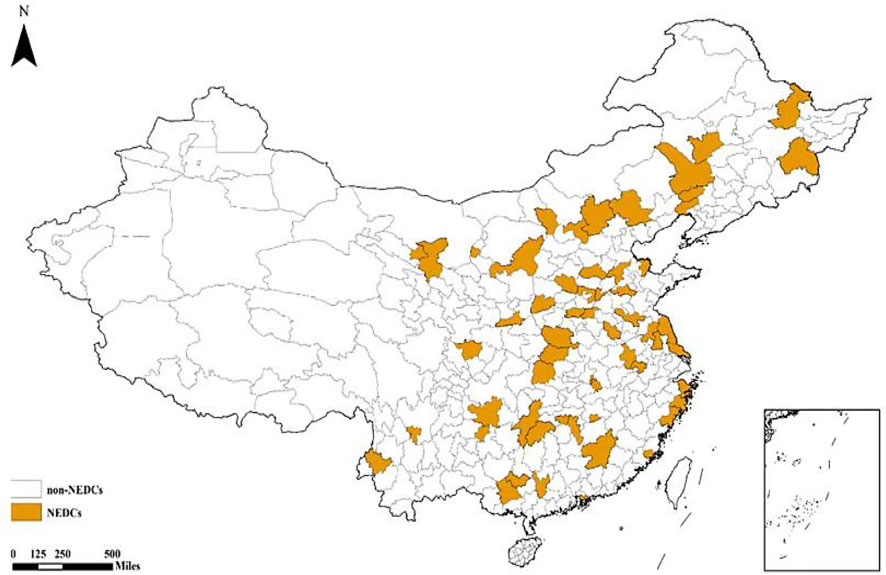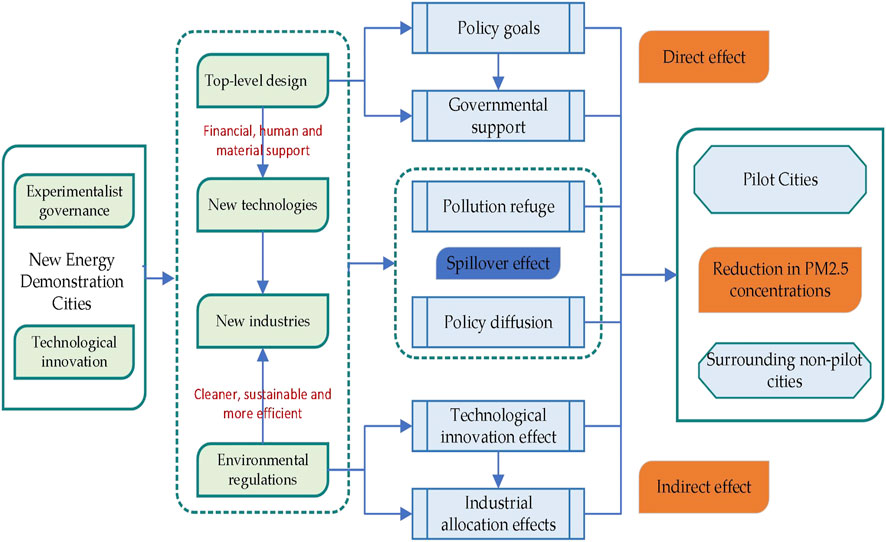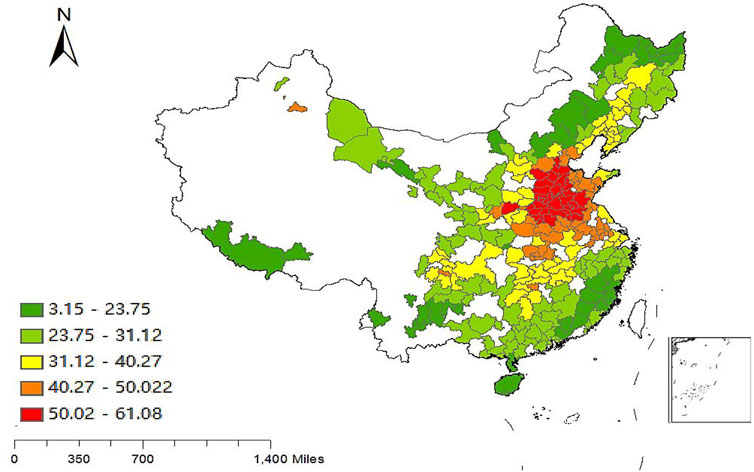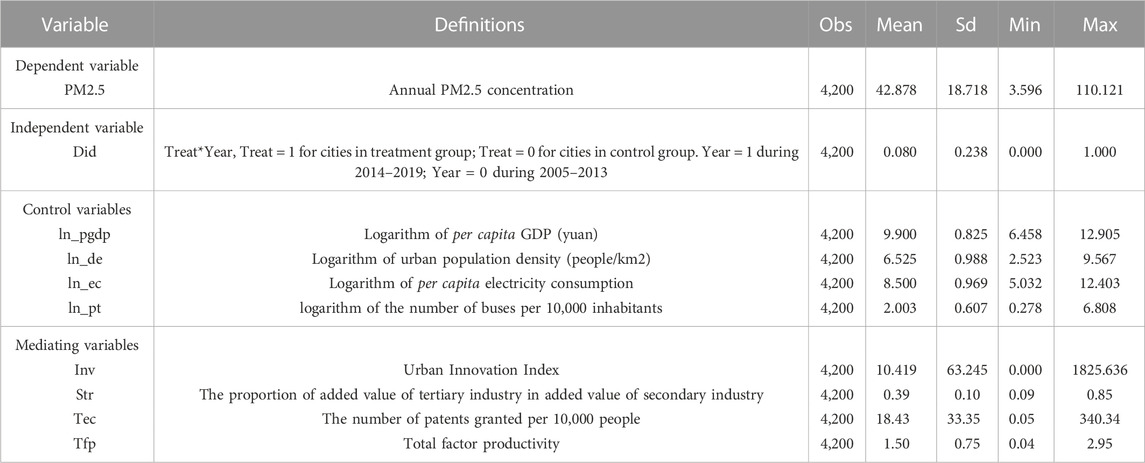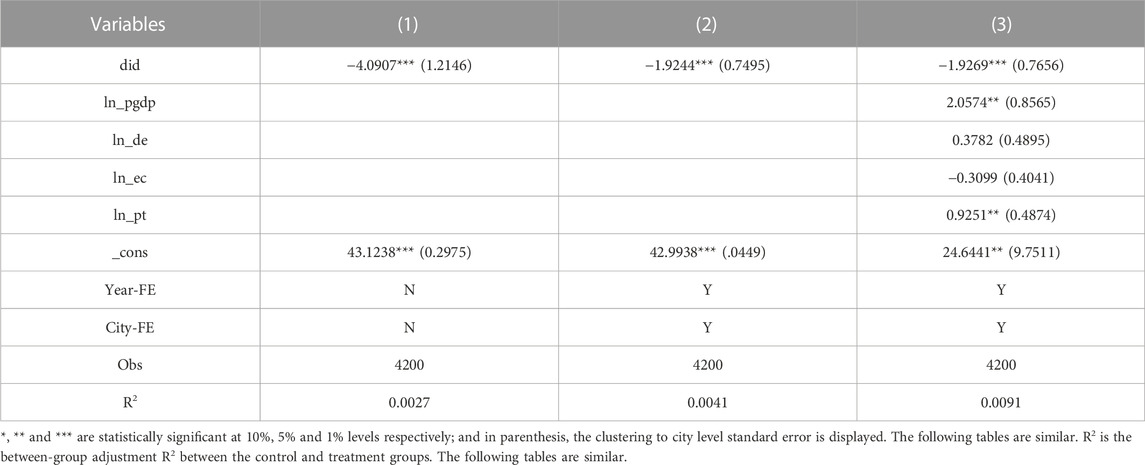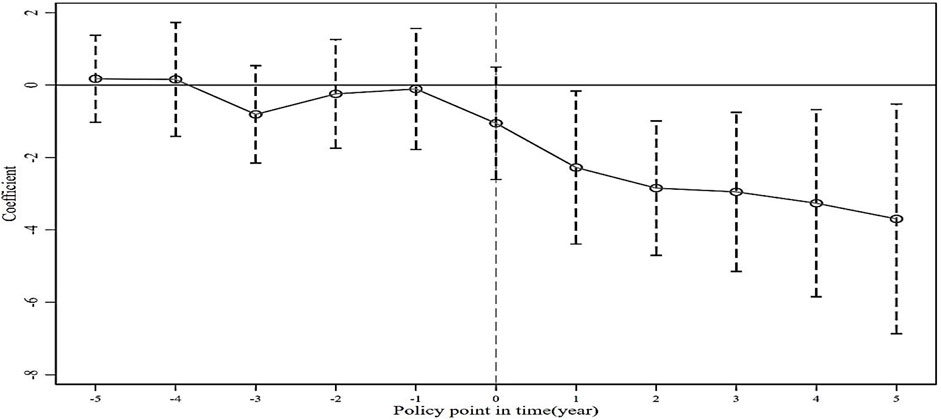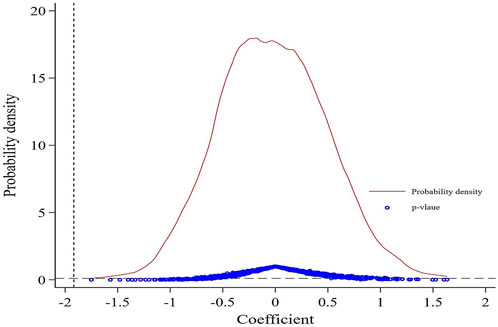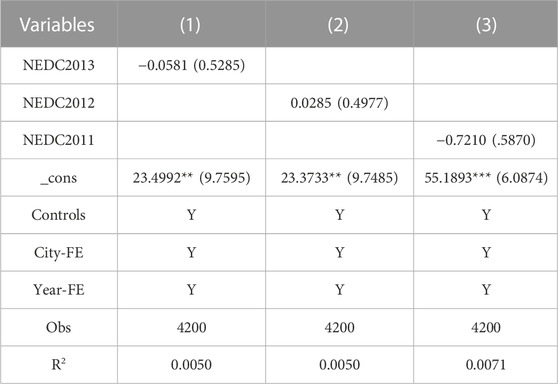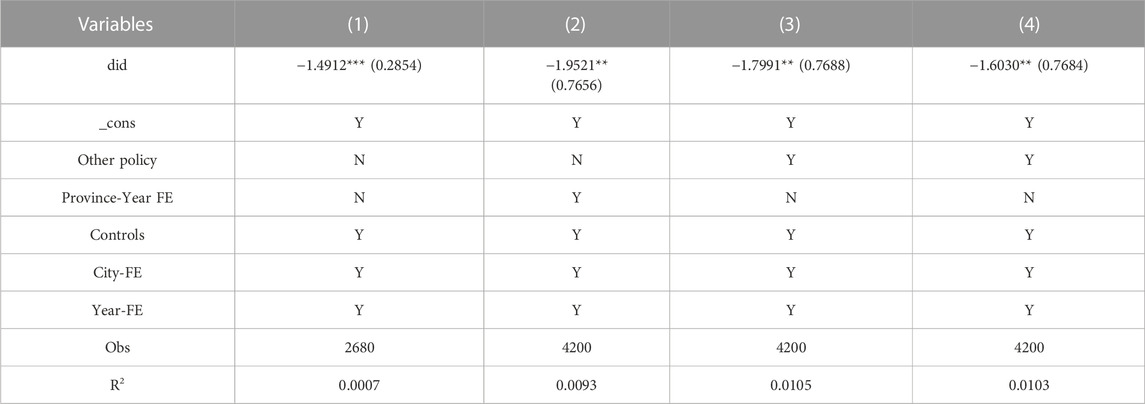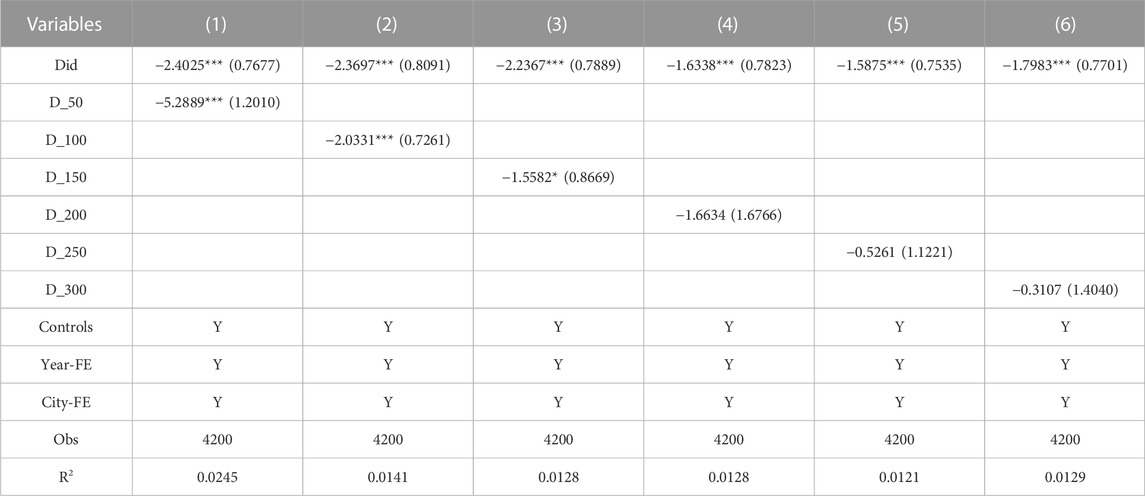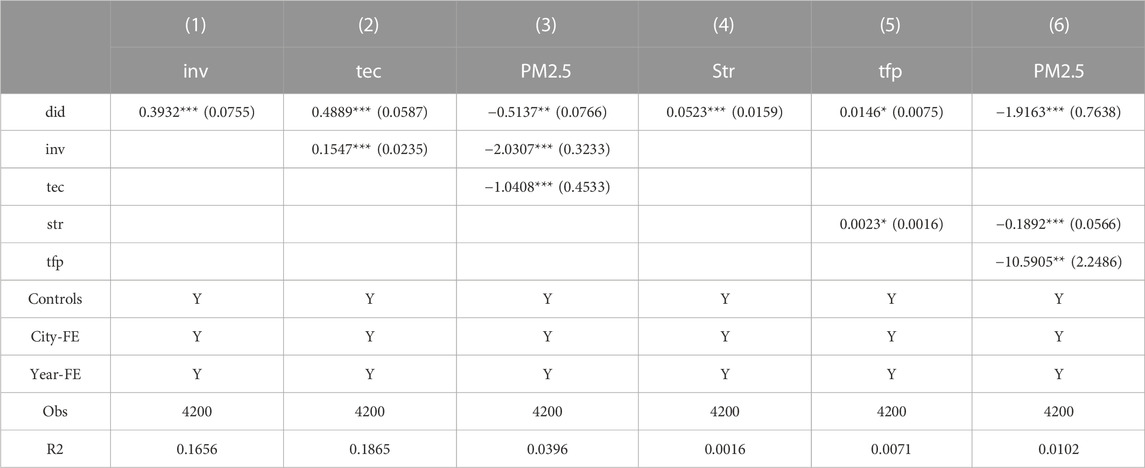- 1Research Center for Economy of Upper Reaches of the Yangtse River, Chongqing Technology and Business University, Chongqing, China
- 2Qinghai University Library, Qinghai University, Xining, China
Introduction: In recent years, China has paid high attention on urban energy innovation, trying to achieve a win–win situation between environmental protection and urban development, and it has formulated a series of policies to promote urban energy innovation.
Methods: Taking China’s new energy demonstration city (NEDC) policy as an example, this paper empirically investigates the impact of China’s urban energy policy on PM2.5 by using a difference-in-differences (DID) model.
Results/Discussion: (1) NEDC policy has reduced PM2.5 concentrations by 4.84% in pilot cities. Moreover, this policy can continue to reduce PM2.5 concentrations for at least 5 years, and the policy effect increases year by year. (2) NEDC policy has spatial spillover effect, which significantly reduces PM2.5 of surrounding cities within 150 km. (3) The PM2.5 reducing effect of NEDC policy is primarily the result of technological effect and allocation effect generated by promoting innovation and industrial upgrading. (4) The PM2.5 control effect of NEDC policy presents an inverted U-shape with the expansion of city size, and is better in cities with low levels of financial support, high levels of human capital and information infrastructure. The conclusions of this paper have important theoretical value for understanding the ecological effect of innovation policy and provide experience for developing countries to implement an experimentalist governance model.
1 Introduction
In the past 40 years, China’s rapid economic development has come at a huge environmental price (Cui and Cao, 2022). According to the " Bulletin on China’s Ecological Environment in 2020″, among the 337 prefecture-level cities in China, only 202 meet environmental quality standards, accounting for 59.9% of all cities, and the annual average PM2.5 concentration is as high as 33μg/m3, far exceeding the 10μg/m3 standard in the World Health Organization’s Air Quality Guidelines. The frequent occurrence of extreme air pollution such as haze and acid rain has caused hundreds of billions of dollars of damage to China every year and has severely constrained the country’s sustainable development (Zhang et al., 2012). Moreover, air pollution has shortened the average human life expectancy by 5 years and causes great harm to residents’ physical and mental health (Chan and Yao, 2008; Beelen et al., 2014). Long-term exposure to fine particulate matter (PM2.5) is considered one of the leading causes of death from cardiovascular disease (Pelucchi et al., 2009; Villeneuve et al., 2015), and elevated PM2.5 concentrations can have a detrimental effect on the respiratory system (Burnett et al., 2018; Lin et al., 2022). In China, Over 300, thousands of people die prematurely due to air pollution every year (Cohen et al., 2017). A series of facts show that air pollution caused by PM2.5 has restricted China’s sustainable economic development and ecological civilization construction.
Air pollution is thought to be mostly caused by energy usage (Bildirici and Gokmenoglu, 2017; Zeng et al., 2020). In pursuit of GDP growth performance evaluation system, Urbanization and industrialization are vigorously promoted, and this is key to China’s rapid economic growth, and it has directly caused an over use of energy resources and significant ecological harm (Liang and Yang, 2019; Wang and Su, 2019). Between 2005 and 2019, With an average yearly growth rate of 4.5%, China’s total energy consumption climbed from 2,613 million tons to 4,870 million tons of standard coal. Early in 2010, China overtook the United States to become the world’s top energy user with a total energy consumption of 3,606 million tons of conventional coal. Meanwhile, as shown in Figure 1, despite the fact that coal accounts for the majority of China’s energy use, the energy mix is being improved. In example, between 2005 and 2019, the percentage of coal usage dropped from 72.4% to 57.7%, and the percentage of new energy consumption—that is, energy derived from sources other than coal, oil, and natural gas—rose from 9.8% to 23.4%, demonstrating a shift in China’s energy system toward greener, renewable sources of electricity.
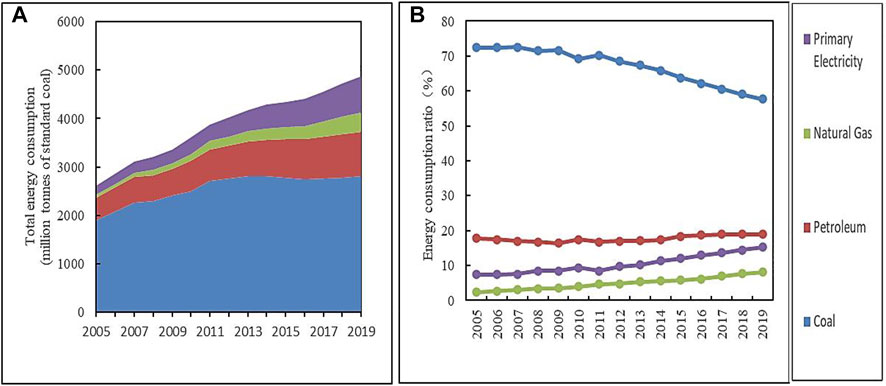
FIGURE 1. China’s Total energy consumption (A) and energy consumption ratio (B) during 2005–2019. Data source: China Statistical Yearbook 2020.
In fact, many countries are accelerating their energy transition from fossil fuels to cleaner and renewable energy sources. For example, the United States is using renewable energy as a transitional energy source to promote a cleaner energy structure (Brown, 2001; Outka, 2012); Germany is reducing fossil energy consumption and promoting the large-scale application of renewable energy (Behrens, 2010); Middle Eastern countries are also continuing to promote the application and development of renewable energy for political and economic reasons (Barnes and Floor, 1996; Scheer, 2013). In a similar vein, China’s government has put in place a number of energy-related regulations to lower air pollution and enhance environmental quality. Among these policies, the New Energy Demonstration City (NEDC) is a typical energy policy recently implemented by the Chinese government (Yang et al., 2021; Feng et al., 2022). In 2014, China’s National Energy Administration announced the first batch of 81 pilot cities as NEDC. To boost the share of new energy consumption, NEDCs must fully utilize the numerous local renewable energy resources, such as solar, wind, geothermal, and biomass. In light of this, it is crucial to determine if the NEDC strategy is successful in decreasing PM2.5, since this information may be used to inform and guide the development of China’s future energy policies.
To date, current research on the issue of new energy cities mainly involves qualitative analysis of new energy city concepts (Gong et al., 2013a), construction planning (Morozumi, 2009), evaluation index systems (Wang and Yi, 2021), strategy selection and governance (Zhang et al., 2020a), while quantitative evaluation is rare (Zhang X. Y et al., 2022). Whether the mechanisms underlying the decreased PM2.5 levels in the new energy demonstration towns need further investigation. It will not only assess how well China’s new energy plan is being implemented, but it will also open up new avenues for reducing urban air pollution (Zhang Q et al., 2022). Optimizing the energy strategy and ecological environment protection measures developed by China and other nations is of utmost importance.
There are three contributions of this study. First, the present study verifies that the experimental governance theory, which is originally set up in Western countries, can also be used to explain new energy policies in the context of China. This is a re-understanding of the experimental governance theory and an extension of Chinese-styled experimental governance. Second, a deeper understanding can be achieved by considering the mediating effects of innovation, technology effect, industrial upgrading and allocation effect in the construction of the influencing NEDC model on pm2.5 concentrations. Third, the spatial spillover effect of NEDC policy is a key issue that has been neglected by existing researches. This paper introduces the influence radius to check the extent of policy diffusion of NEDC policy to the surrounding areas, which can fill the gap in relevant studies. The results of this paper expand the research perspective of sustainable development theory, providing a reference for the development-oriented regions of the world with “energy innovation and green development” and providing a reference for formulating and implementing urban development strategies.
The remainder of the paper is organized as follows: The theoretical hypothesis is presented in Section 2 after a study of the NEDC building policy’s historical context. The identification approach, variables, and data are introduced in Section 3. The four hypotheses are tested in Section 4 and the regression results are shown. Section 5 provides further analysis of spatial effects and heterogeneity. Section 6 provides the conclusions and related policy implications.
2 Policy background, theoretical analysis and hypothesis
2.1 Policy background
Pilot governance is a kind of government with distinctive Chinese features that is regularly used by the central government (Chen et al., 2015; Zheng and Li, 2020). In China, the issue of uneven regional development is still front and center (Gu et al., 2016). As a result, it is challenging for the government to create a uniform and effective energy policy throughout the policymaking process. In several domains, the central government has implemented a “trial first” approach of policy development in accordance with the Chinese leadership’s “crossing the river by feeling the stone” dictum (Ye et al., 2010; Zhang and Studies, 2015). The government provides a reproducible and popularized paradigm of progressive change by synthesizing the experiences and refining the approach (Luo and Zhan, 2018). China has several different kinds of experimental regions, including demonstration areas, special zones, new areas (Heilmann, 2008; Ma et al., 2013). The NEDC policy is an example of pilot governance in the area of energy policies.
In January 2014, the National Energy Administration announced that 81 pilot demonstration cities and nine industrial parks were identified as NEDC. There are 57 prefecture-level cities remaining after removing the district cities, independent regions, and district from the list of NEDC (see Figure 2). The NEDC policy is an institutional attempt at energy policy (Gong et al., 2013a). The Chinese government has made a top-level design in terms of objectives, concepts, technologies and development. Unlike previous energy policies, in order to optimize the energy mix and advance sustainable development from a city viewpoint, the NEDC policy stresses the full use of locally plentiful renewable energy sources, such as solar, wind, and biomass, in the construction of urban areas’ energy infrastructure (Kolhe, 2012; Cheng et al., 2023).
2.2 Theoretical analysis and hypothesis
The construction of NEDC can reduce the dependence on fossil resources (Cai et al., 2022). First, in the construction of NEDC, local governments should not only accept macro supervision and fulfil the development targets set by the state, but also take the initiative to make energy restructuring and innovate development paths. Localities are actively exploring the application of new energy in urban power supply, heating and building energy efficiency, reducing cities’ reliance on fossil energy and increasing the efficiency of new energy use and consumption share. Pilot cities can also gradually rationalize their energy use structure by limiting the use of coal. Second, the NEDC energy concept can be widely recognized and applied (Yang et al., 2017; Yang, 2021). The NEDC follow the concept of adapting to local conditions and rational development, relying on resource endowments and coordinating the development of different types of new energy sources. The construction of pilot cities should consider not only the main urban areas, but also rural areas, recycling all types of new energy from the perspective of the whole city and building a new energy development pattern that is whole process, whole energy, whole region, whole field, whole cycle and whole participation (Zhang Q et al., 2022). Third, the construction of NEDC can promote the industrialization of new energy technologies and the clustering of new energy industries (Gong et al., 2013a). NEDC focus on promoting new energy development at the technical and industrial levels, exploring the combination of new energy and buildings, the application of microgrid technology, biomass fuel technology, etc., gradually realizing the industrialization of new energy technology and the proliferation of new energy industry clusters, thus promoting the formation of the “new energy technology - new energy industry - new energy city” spatial chain. This study puts forward Hypothesis 1 based on the analyses just mentioned.
Hypothesis 1. The NEDC policy can directly reduce cities’ PM2.5.
The consequences of regional pilot air pollution reduction strategies may have geographical spillover effects in China (Barbieri, 2019). On the one hand, the regional pilot policy may have an ‘environmental refuge effect’. That is, heavily polluting enterprises may relocate to neighboring non-pilot cities to avoid the increased production costs associated with stricter environmental regulations in the pilot cities (Carmona and Landis, 1999; Dosen and Ostwald, 2016; Peng, 2020). As a result, the implementation of the pilot policy may exacerbate PM2.5 concentrations in nearby non-pilot cities. On the other hand, the regional pilot policy may also have a policy diffusion effect, thereby reducing air pollution in the surrounding areas (Mooney, 2001; Grossback et al., 2004; Shipan and Volden, 2008). That is, nearby cities follow the example of the pilot cities and reduce air pollutant emissions, or reduce pollution from shared air due to the reduction in pollutant emissions from the pilot cities (Shipan and Volden, 2012). Therefore, we make hypothesis 2:
Hypothesis 2. The NEDC policy has spatial spillover effect on PM2.5.
It is widely acknowledged that the development of new energy demonstration cities stimulates urban innovation and industrial advancement, leading to repercussions on resource allocation and technology (Tan et al., 2018; Cheng et al., 2023). The effectiveness of innovation, industrial upgrading, technological impacts, and resource allocation effects in decreasing pollution has been demonstrated (Zhang et al., 2020b; Ouyang et al., 2020). As a result, this article examines how two chain reactions—the “innovation-technology impact” and the “industry upgradation-allocation effect"—can help NEDC policies lower PM2.5. Specific analysis is as follows:
(1) Innovation-technology effect. The concentration of high-tech industries has a positive effect on improving the regional ecological environment (Florida, 2003). The new energy industry is a technology-intensive industry, and insufficient investment in R&D and lack of talent can limit technological innovation (Saxenian, 2005). Pilot cities must advance the development of technical innovation in new energy applications and raise the share of new energy consumption in accordance with the New Energy Demonstration City Evaluation Index System and Description’s particular requirements. And the construction of NEDC has led the government to pay more attention to independent research and development capabilities, and technological innovation resulting from increased investment in research and development can promote the development and application of new energy. Technological innovation has a direct positive impact on the coordinated development of economic, energy and environmental systems, and innovation in new energy technologies is considered to be a key factor in rising green productivity (Zhong and Li, 2020). At the same time, technological innovation can effectively reduce the intensity of coal consumption, reduce energy consumption per unit of GDP output, and create energy-saving and emission reduction mechanisms through changes in factor productivity, thereby reducing air pollution (Kaufmann, 2004). We make hypothesis 3:
Hypothesis 3. NEDC policy drives urban innovation, resulting in technological effects to reduce PM2.5.
(2) Industrial upgradation-allocation effect. The direct goal of NEDC construction is to increase the proportion of new energy use and consumption, which means that new energy vehicles, photovoltaic power generation, new energy buildings, smart grids and other industrial chains will speed up their development (Cheng et al., 2023). Based on new energy technology, the green development model and energy saving and environmental protection concepts of new industries will have a demonstration and driving effect on other industries, compelling the industrial structure to go in the direction of rationalization by progressively transforming or removing outdated high energy- and high-pollution businesses (Bossink, 2020); at the same time, in order to reach the set target and optimize the energy structure, local governments will take the initiative to eliminate backward energy enterprises and eliminate unnecessary energy consumption, thus promoting industrial upgrading and reducing pollution emissions (Wu et al., 2018). Therefore, we make hypothesis 4:
Hypothesis 4. NEDC policy drives industrial upgrading, resulting in allocation effects to reduce PM2.5.
Figure 3 shows the research framework of this paper.
3 Materials and methods
3.1 Methodology
The selection of NEDC has a certain randomness, and the policy can be regarded as a quasi-natural experiment. Therefore, this paper investigates the impact of NEDC policy on PM2.5 based on the DID model, which is set up as in formula (1):
Where, city is represented by i (=1, 2.280), year is represented by t (=2005, 2006, … , 2019). PM2.5 indicates the concentration of PM2.5 in a city. Did determines if city I is a new energy demonstration city by using the difference-in-differences estimator. A group of control variables known as X are used to account for the impact of other variables on PM2.5.
PM2.5 has spatial mobility, and new-energy city pilot may lead to pollution migration on the one hand and policy diffusion effect on the other hand. Therefore, in order to explore whether the new-energy city pilot has an impact on the surrounding area, we construct the following spatial DID model.
In Formula (3), we incorporate a set of new regression variables
Considering the interaction between innovation and technology effects, i.e. the time-series characteristics of innovation for technology effects. In addition, the relationship between industrial upgrading and the allocation effect is similar. Therefore, with reference to existing studies, the chain mediated effects model is designed to address this issue.
where,
The event analysis model is shown in formula (6):
Based on formula (1), we construct a new variable
3.2 Variables and data
3.2.1 Dependent variable
As mentioned earlier, the dependent variable in this paper is PM2.5 concentration, which is not prone to settlement and can be measured more accurately by re-mote sensing techniques. It does not settle easily and can be measured more accurately by remote sensing techniques (Cheng et al., 2019). Based on the global grid data provided by the Washington University in St. Louis website, we obtained the annual average PM2.5 concentration data for China by filtering. PM2.5 Concentrations of 280 Chinese prefecture-level cities in 2019 are shown in Figure 4.
3.2.2 Core explanatory variable
We examine the impact of NEDC construction as a policy shock on air pollution. Two dummy variables—Treat and Year—identify the main explanatory factors. A city’s membership in the treatment or control group, or whether it is a NEDC pilot city, is indicated by the variable Treat. Cities were given a value of 1 for the experimental group and a value of 0 for the control group. 223 non-NEDCs and 57 NEDCs made up the research sample. The variable Year, which is 1 for the years 2014 through 2019 and 0 for the years prior to 2014, specifies whether or not the NEDC policy is in effect. Due to this, the main explanatory factor did may be written as a Treat–Year interaction term.
3.2.3 Control variables
Refer to the existing relevant literature (Wu et al., 2018; Bossink, 2020; Zhang X. Y et al., 2022), to remove additional interference effects, we choose a number of control variables, including economic development (in pgdp), which is represented as the logarithm of per capita GDP. Population density (in_de), which is expressed by logarithm of per km2 population. Electricity consumption (in_ec), which is expressed by logarithm of per capita electricity consumption. Public transport (in_pt), which is assessed by logarithm of the number of buses per 10,000 inhabitants.
3.2.4 Mediating variables
Innovation (inv), as measured by the Urban Innovation Index, is one of the mediating factors. Industrial upgrading (str) is determined by the ratio of tertiary industry added value to secondary industry added value. The technology impact (tec), which is calculated as the number of patents issued for every 10,000 residents in a city Total factor productivity (tfp), a measure of the allocation impact.
The sample data was compiled from a panel dataset of 280 Chinese cities from 2005 to 2019 and was taken from statistical publications like the China Urban Statistical Yearbook, China Statistical Yearbook, China Urban Construction Statistical Yearbook, and China Urban and Industrial Innovation Report. Additionally, based on provincial price indices, all nominal indicators have been updated to 2005 constant prices. The original dataset for this study includes less missing values due to the current data disclosure; thus, this work is supplemented by a linear interpolation approach using prior research (Gong et al., 2013b; Yang et al., 2021). Table 1 displays descriptive data for the relevant variables.
4 Empirical results
4.1 The effect of NEDC policy on PM2.5
The baseline regression results are shown in Table 2, Among them, regression (1) is an ordinary least squares (OLS) estimate containing only the independent and de-pendent variables. The results show that the coefficient of NEDC policy is −4.0907 and significant at the 1% statistical level, which may be due to three reasons. The first is the characteristics of the time trend; All cities show an overall decreasing trend in PM2.5 concentrations as the year progresses. The second is sample selection bias; that is, compared to the non-pilot cities, PM2.5 concentrations in the new energy demonstration cities showed a rapid trend of mitigation over the sample period. The third is the policy effect; that is, NEDC policy has been effective in reducing PM2.5 concentrations in pilot cities. In the regression (2) and (3), we control for year, city fixed effects and add control variables. The results show that the coefficient of the policy remains significantly negative. The above results show that the NIEDC policy can significantly reduce PM2.5 in the pilot cities, which is consistent with Hypothesis1.
In addition, using the results from Table 2’s regression (3), we estimated the decreasing effect size. The average 1.93 point decrease in PM2.5 concentration is anticipated as a result of NEDC policy. During the sampling period, the average PM2.5 concentration is 39.88 μg/m3 in pilot cities. As a result, the NEDC policy reduces PM2.5 concentration by about 4.84%.
4.2 Analysis of the dynamic impact of the NEDC policy on PM2.5 concentrations
In this part, we modify the dynamic effects of NEDC policy and use event analysis to look at parallel patterns.
Figure 5 reports the variation of the coefficient of variable
The coefficient of the NEDC policy was considerably negative after the policy’s adoption, indicating that the NEDC policy drastically decreased the PM2.5 concentration. The PM2.5 reduction effect of the NEDC policy can endure for more than 5 years in terms of the continuity characteristics of the policy impact. The NEDC policy’s ability to reduce PM2.5 has become stronger each year in terms of policy impact. This exemplifies the benefit of China’s pilot program, which allows the government to dynamically change and improve the policy implementation plan in accordance with the success of the NEDC policy, therefore improving the efficacy of air pollution control year after year.
4.3 Robustness tests
4.3.1 Placebo test
A placebo test is necessary to further rule out the impact of other unidentified factors on the choice of pilot towns and to confirm that the findings of this study are caused by the NEDC policy (Feng and Nie, 2022). In this paper, we conducted a placebo trial by randomly assigning pilot cities; specifically, at each sampling, 57 cities were arbitrarily selected as the treatment group (the original number of cities in the treatment group was 57), and the remaining 223 cities were used as a randomized control group. We performed 1000 independent replications and calculations based on formula (1). Figure 6 depicts the distribution of the predicted regression coefficients for the independent replicate experiments. It is easy to determine that the distribution of the estimated coefficients is positively biased, centered at 0, with p-values mainly above 0.1. The true estimated coefficients significantly deviate from the placebo test estimates. The probability of a random sample generating the estimated coefficients from the preceding baseline regression is low. In conclusion, these results are sufficient to suggest that the NEDC policy effects found in this paper are unlikely to be the result of other externalities, which suggests that the results pass the placebo test.
4.3.2 Counterfactual test
To prevent the interference of additional random variables, the counterfactual test was taken to change the implementation time, and the implementation time was estimated 1 year earlier (2013), 2 years earlier (2012), and 3 years earlier (2011), respectively. Table 3 displays the outcomes of the counterfactual tests. The effects of advancing the implementation time on the policy coefficients are all insignificant, which indicates that the changes in PM2.5 in the pilot cities are not interfered by other factors, but are brought about by the NEDC policy, thus arguing the robustness of the result.
4.3.3 Use the PSM-DID method
In an ideal quasi-natural experiment, the samples of the treatment and control groups are chosen at random (Yang et al., 2021). However, when China selects NEDC pilot cities, it must take into account the strengths of each city in various areas, including the economy and the environment. Prior to the introduction of the policy, this might result in sample selection bias and cause substantial discrepancies in between treatment and control groups (Yang et al., 2021). In this study, sample selection bias is minimized by matching samples from the treatment and control groups one to one, a technique known as propensity score matching (PSM). After excluding samples that were not successfully matched. The PSM-DID regression results are shown in column (1) of Table 4. Specifically, there is no change in the sign or significance of the policy explanatory variable DID, indicating that the NEDC policy reduced PM2.5 concentrations, which suggests that the findings of this paper are robust.
4.3.4 Add the joint province-year impacts
In the study above, we took time fixed effects and area fixed effects into consideration. However, since policies in China are generally introduced at the provincial level, and some provinces may also introduce some urban air pollution control policies, and this effect of different provinces over time is difficult to be captured by the above time-fixed and city-fixed effects (Feng and Nie, 2022), this paper further introduces joint province-time fixed effects as a way to control for the policy effects at the provincial level. Robustness tests are conducted on the previous findings. The regression results after introducing the joint province-time fixed effects are shown in column (2) of Table 4. It can be found that the core explanatory variable did not change significantly after controlling for the province-time effect, which further supports the previous conclusion.
4.3.5 Control other policies effect
Other environmental and energy regulations that China implemented throughout the study’s sample period may have had an impact on air pollution and, consequently, the reliability of the estimation results in this work. As a result, we must stop these policies’ impacts. There are two main policies in particular: the PM2.5 emission trading pilot program and the low-PM2.5 city construction strategy. We created two dummy policy variables, Low-PM2.5 and Trading, and added them to the baseline model to eliminate these policies’ confounding effects. The outcomes are displayed in Table 4’s rows (3) and (4). It is clear that the primary explanatory variable did not change much, which supports the validity of the research presented in this work.
5 Further analysis
5.1 Added effects: The spatial spillover test
In this part, we examine whether surrounding non-pilot cities are affected by the NEDC pilot cities. The outcomes are displayed in Table 5. It has been discovered that within a radius of 0.150 km, the NEDC policy has a considerable suppressive impact on PM2.5 in the surrounding non-pilot city in addition to reducing PM2.5 in the pilot city. We specifically discover that the spillover impact diminishes with growing distance from the cities hosting new energy demonstration projects. The spillover impact reduces from 5.2889 to 1.5582 and the significance threshold shifts from 1% to 5% when the separation radius rises from 50 km to 150 km. This suggests that the 150km effective range of the NEDC policy spillover effect. This test result aligns with the previously mentioned theoretical predictions. As a result, hypothesis 2 is accurate.
Furthermore, the conclusion of spatial effects needs to be treated with caution, as the movement of PM2.5 needs to be considered further. Because pollution reduction in one city can certainly benefit the downwind area which is a very important factor to look into the source emission reduction. Sometimes, the air quality in one city may be mainly dependent on the emission in upwind cities instead of the city itself, In particular, the spatial effects within 50 km of the pilot city are concluded Table 6.
5.2 Mechanism analysis
The aforementioned findings essentially show that the NEDC policy may cut urban PM2.5 concentrations by a substantial amount while having significant negative geographical spillover effects on non-pilot cities within 150 km. In this part, we look at various processes that might underlie the operation of new-energy demonstration cities.
The aforementioned findings essentially show that the NEDC policy may cut urban PM2.5 concentrations by a substantial amount while having significant negative geographical spillover effects on non-pilot cities within 150 km. In this part, we look at various processes that might underlie the operation of new-energy demonstration cities. A partial chain mediation effect of the innovation and technology effects was found, as shown by the estimated coefficients of the did variable, innovation, and technology effects in column (3), which are −0.5137, −2.0307, and −1.0408, respectively. Third hypothesis is confirmed. The same industrial upgrading (str) and total factor productivity (tfp) metrics are applied in columns (4) through (6). The NEDC policy can also lower PM2.5 through two intermediary channels, industrial upgrading and allocation effects, which are not difficult to understand. Fourth hypothesis is confirmed.
We separated the mediating impact into two categories based on prior research: independent mediating effect and chain mediating effect (Taylor et al., 2008), as shown in Table 7. Additionally, “NEDC policy innovation reducing PM2.5,” “NEDC policy technology effect reducing PM2.5,” “NEDC policy industrial upgrading reducing PM2.5,” and “NEDC policy allocation effect reducing PM2.5″are designated as the independent mediating effects, and their respective effect sizes are −0.7985, −0.5088, −0.0098, and −0.1546. The chain mediation effect is denoted by the terms “NEDC policy innovation technology impact lowering PM2.5″and “NEDC policy industrial upgrading allocation effect reducing PM2.5,” with effect sizes of −1.3706 and −0.1712, respectively. In terms of the proportional importance of the transmission mechanism, the innovation and technology effect accounts for 69.83% of the overall PM2.5 reduction benefit of NEDC policy. In new-energy cities, the relative contribution share of industrial upgrading and allocation impact to PM2.5 reduction is 8.72%. As a result, for NEDC policy to lower PM2.5, innovation, technological effect, industry upgrading, and allocation impact are significant channels. In the NEDC policy, innovation-induced technological impacts are a dominant role in PM2.5 reduction.
5.3 Heterogeneity analysis
5.3.1 Heterogeneity analysis of city size
In this part, we further investigate whether city size affects the NEDC policy’s ability to reduce PM2.5. The regression results are displayed in Table 8 with reference to the city size categorization criteria for China in 2020.
For small and medium-sized cities, NEDC policy can reduce PM2.5, but not significantly. One possible explanation is that small and medium-sized cities have a weaker technological base and less efficient use of resources, which leads to an inability to effectively exploit the PM2.5 reduction effect of the NEDC policy.
For large cities, the NEDC strategy, according to our research, considerably decreased PM2.5 concentrations. This makes some sense since industrial upgrading may be used in major cities to reduce PM2.5 thanks to the advantages of higher innovation and better technology. Additional research reveals that different major city types have distinct impacts on PM2.5 reduction. Megacities and Type II big cities can lower PM2.5, however the impact is minimal. At the 1% level, only Type I major cities are notably unfavorable. Overall, the decrease effect of NEDC policy on PM2.5 has an inverted u-shaped feature with increasing city size.
5.3.2 Heterogeneity analysis of urban characteristics
This study divides the sample cities into distinct financial, human capital, and material categories based on urban factors such as government spending on education, the number of higher education instructors per 10,000 inhabitants, and Internet usage. Table 9 displays the results of the regression.
Under high human capital levels, the NEDC policy has a lowering effect on PM2.5 that is −5.3211, which is noticeably larger than the effect under low human capital levels. Talent is the most active and positive resource in innovation activities, and the NEDC policy is more likely to be effective in a city with a higher level of human capital, and the PM2.5 reduction effect in the pilot city is more significant. Thus, the construction of new-energy demonstration cities places high demands on the human capital level of the workforce.
For financial level, NEDC policy has a smaller effect on PM2.5 reduction in cities with higher financial levels than in cities with lower financial levels. The financial level indicator also represents the government’s administrative intervention in new energy cities, and the increased government intervention did not enhance the PM2.5 reduction effect. Because funding for government action sometimes focuses on short-term economic gains and may result in more harmful emissions.
For material level, NEDC policy has a stronger effect on PM2.5 reduction in cities with higher material levels than in cities with lower material levels. An important foundation for new energy cities is modern information technology. In the group of cities with low information infrastructure, the NEDC policy does not have the proper effect due to the lack of foundation for modern information technology development. In contrast, NEDC policies in cities with high information infrastructure can achieve better PM2.5 reduction effects. Overall, the supports for the construction of new energy demonstration cities in terms of funding, human capital and information infrastructure development are beneficial to reducing urban PM2.5.
6 Conclusion, discussion and policy implications
6.1 Conclusion and discussion
Demonstration of new energy Cities will innovate the urban energy system, which will have a significant influence on the control of urban air pollution (Gong et al., 2013b). New energy demonstration cities innovate urban governance models and will have an important impact on urban air pollution control. Based on panel data from 280 cities in China from 2005 to 2019, this study uses DID model to explore the impact of NEDC policy on PM2.5. The following basic conclusions are presented.
(1) The NEDC policy significantly reduced PM2.5 concentration in the pilot cities, specifically, PM2.5 concentration in the pilot cities were reduced by an average of 4.84%. Moreover, the NEDC policy can sustainably reduce PM2.5 concentration for a mini-mum of 5 years.
(2) The NEDC policy has a spatial spillover effect on PM2.5. Specifically, the NEDC policy can reduces PM2.5 concentration in surrounding non-pilot cities within a maximum 150 km range.
(3) Innovation, technology effect, industrial upgrading and allocation effect are the four effective transmission mechanisms of NEDC policy to reduce PM2.5.
(4) The PM2.5 reduction effect of the NEDC policy increases and then decreases in an in-verted U-shape with the expansion of city size. And cities with lower financial levels and higher human capital levels and information infrastructure have better emission reduction effects.
Based on the aforementioned study findings, we conclude the following consequences. First, China has to systematically promote and enhance the new energy policy pilot program while summarizing and enhancing the model of experimentalist governance and gradual transformation that guides the country’s innovation policy. It is also crucial to encourage the symbiosis between NEDC cities and non-NEDC cities in terms of policy, science and technology, and environmental governance, to further enhance the spatial spillover impact of the NEDC policy, to take full advantage of the radiating and leading “point to surface” role of NEDC cities, and to advance the governance of PM2.5 emissions in non-NEDC cities. Second, it is essential to develop the urban innovation system and foster an atmosphere conducive to innovation. The construction of innovative cities should consider technological innovation as a priority, strengthen the training of skilled workers, improve the construction of information infrastructure, increase the proportion of high-tech industries, focus on supporting the development of energy and environment-friendly industries, and promote the transformation of the industrial structure into a green and low-PM2.5 industry. Third, the analysis of urban size heterogeneity reveals that the solution to urban development issues is not the excessive size of cities, but rather the development of new urban governance models. Large cities can capitalize on the NEDC policy dividend to leverage scale and agglomeration effects in order to lower urban PM2.5 emissions, thereby reducing or eliminating the detrimental effect that urban challenges have on urban growth. Simultaneously, small and medium-sized cities should concentrate on enhancing their information infrastructure and human capital so as to maximize the effectiveness of urban government and operational efficiency. Fourth, the increased government intervention has weakened the effect of NEDC policy on PM2.5 reduction. Therefore, the government should clarify its role and position in the process of constructing innovative cities and avoid overstepping its bounds. While the market plays a crucial role in the development of innovative cities, it is also essential to prevent the government from playing a passive role. Overall, the government should play a positive role as a “night watchman” in the process of constructing innovative cities and create a healthy and orderly new energy environment.
It should be mentioned that this paper’s research approach and concepts still need to be improved. The first limitation of this study is that it only looks at samples from Chinese cities. As a result, future research on the impact of energy policy on environmental pollution has to be more thorough. Second, this study primarily bases its mechanism analysis on the standard theoretical framework and relevant regulations, which may ignore other potential mechanisms, and more empirical studies are needed to further complement and improve the relevant impact mechanisms. Third, in robustness testing, we used a range of methods such as PSM-DID to mitigate the endogeneity problem, but a better approach is to test using instrumental variables, which is a challenging yet important piece of work for future studies.
6.2 Policy implications
This study can provide experience in implementing experimental governance models in developing countries. The study presented above has led to the following pertinent policy suggestions being put forth.
(1) In general, because China’s NEDC policy has demonstrated to be a successful method of reducing air pollution, the Chinese government can continue to support NEDC construction policy, for instance by enlarging the boundaries of demonstration cities or bringing demonstration projects to the county level.
(2) The mechanism analysis shows that innovation and industrial upgrading are important channels for NEDC policy to reduce PM2.5 concentration. Therefore, China should focus on increasing investment in science and technology, encouraging technological innovation, and prompting R&D entities to develop more effective environmental technologies. At the same time, support the development of green industries through policy support, financial and tax incentives. For example, prioritize the development of low energy consumption, high resource utilization and low pollution enterprises, and gradually guide the transformation of high energy consumption and high pollution enterprises.
(3) Given the varied effects of China’s NEDC policy on air pollution, future policy design should be adapted to regional circumstances and new energy development plans should be implemented in a variety of ways. New energy demonstration cities should combine new energy development with local energy resources and implement differentiated development strategies for different regions and types of cities to ensure optimal substitution and conversion within the urban energy structure.
Data availability statement
The original contributions presented in the study are included in the article/supplementary material, further inquiries can be directed to the corresponding author.
Author contributions
MY conceptualized; WY methodology; MY and WY software validated; MY formal analysis, ZW, MY, and JL investigation, ZW resources, MY data curation, MY writing—original draft preparation, ZW and MY writing—review and editing, MY and JL. The published version of the work has been reviewed and approved by all authors.
Funding
The National Social Science Fund of China (Grant/Award Number: 17XTQ011) and the MOE Project of Key Research Institute of Humanities and Social Sciences in Chinese Universities (Grant/Award Number: 16JJD790063) provided financial support for this study.
Acknowledgments
The authors gratefully accept support from the Chinese National Social Science Foundation and the MOE Project of Key Research Institute of Humanities and Social Sciences in Chinese Universities.
Conflict of interest
The authors declare that the research was conducted in the absence of any commercial or financial relationships that could be construed as a potential conflict of interest.
Publisher’s note
All claims expressed in this article are solely those of the authors and do not necessarily represent those of their affiliated organizations, or those of the publisher, the editors and the reviewers. Any product that may be evaluated in this article, or claim that may be made by its manufacturer, is not guaranteed or endorsed by the publisher.
References
Barbieri, E. (2019). Industrial policy in China: The planned growth of 400 industrial towns in the Cantonese region. Available at: https://academic.oup.com/cjres/article/12/3/401/5581697.
Barnes, D. F., and Floor, W. (1996). Rural energy in developing countries: A challenge for economic development. Ctries. A Chall. Econ. Dev. 21, 497–530. doi:10.1146/annurev.energy.21.1.497
Beelen, R., Raaschou-Nielsen, O., Stafoggia, M., Andersen, Z. J., Weinmayr, G., Hoffmann, B., et al. (2014). Effects of long-term exposure to air pollution on natural-cause mortality: An analysis of 22 European cohorts within the multicentre ESCAPE project. Lancet 383 (9919), 785–795. doi:10.1016/s0140-6736(13)62158-3
Behrens, A. J., (2010). The role of renewables in the interaction between climate change policy and energy security in Europe, 1, 5. doi:10.1201/b10163-10
Bildirici, M. E., and Gokmenoglu, S. M. (2017). Environmental pollution, hydropower energy consumption and economic growth: Evidence from G7 countries. Renew. Sustain. Energy Rev. 75, 68–85. doi:10.1016/j.rser.2016.10.052
Bossink, B. (2020). Learning strategies in sustainable energy demonstration projects: What organizations learn from sustainable energy demonstrations. Renew. Sustain. Energy Rev. 131, 110025. doi:10.1016/j.rser.2020.110025
Brown, M. A. (2001). Market failures and barriers as a basis for clean energy policies. Energy Policy 29 (14), 1197–1207. doi:10.1016/s0301-4215(01)00067-2
Burnett, R., Chen, H., Szyszkowicz, M., Fann, N., Hubbell, B., Pope, C. A., et al. (2018). Global estimates of mortality associated with long-term exposure to outdoor fine particulate matter. Proc. Natl. Acad. Sci. U. S. A. 115 (38), 9592–9597. doi:10.1073/pnas.1803222115
Cai, D., et al. (2022). “Analysis of energy storage configuration of guangshui new power system with new energy science and technology demonstration project,” in Power System and Green Energy Conference (PSGEC), Shanghai, China, 25-27 August 2022 (IEEE).
Carmona, D. M., and Landis, D. A. (1999). Influence of refuge habitats and cover crops on seasonal activity-density of ground beetles (Coleoptera: Carabidae) in field crops. Environ. Entomol. 28 (6), 1145–1153. doi:10.1093/ee/28.6.1145
Chan, C. K., and Yao, X. (2008). Air pollution in mega cities in China. Atmos. Environ. 42 (1), 1–42. doi:10.1016/j.atmosenv.2007.09.003
Chen, M., Qian, X., and Zhang, L. J. E. (2015). Public participation in environmental management in China: Status quo and mode innovation. Environ. Manag. 55 (3), 523–535. doi:10.1007/s00267-014-0428-2
Cheng, K. C., Tseng, C. H., and Hildemann, L. M. (2019). Using indoor positioning and mobile sensing for spatial exposure and environmental characterizations: Pilot demonstration of PM2.5 mapping. Environ. Sci. Technol. Lett. 6 (3), 153–158. doi:10.1021/acs.estlett.8b00694
Cheng, Z. H., Yu, X. J., and Zhang, Y. (2023). Is the construction of new energy demonstration cities conducive to improvements in energy efficiency? Energy 263, 125517. doi:10.1016/j.energy.2022.125517
Cohen, A. J., Brauer, M., Burnett, R., Anderson, H. R., Frostad, J., Estep, K., et al. (2017). Estimates and 25-year trends of the global burden of disease attributable to ambient air pollution: An analysis of data from the global burden of diseases study 2015. Lancet 389 (10082), 1907–1918. doi:10.1016/s0140-6736(17)30505-6
Cui, H. Y., and Cao, Y. Q. (2022). Do smart cities have lower particulate matter 2.5 (PM2.5)? Evidence from China. Sustain. Cities Soc. 86, 104082. doi:10.1016/j.scs.2022.104082
Dosen, A. S., and Ostwald, M. (2016). territory, and architecture. Evid. prospect-refuge theory a meta-analysis Find. Environ. Prefer. Res. 3 (1), 1. doi:10.1186/s40410-016-0033-1
Feng, Y., and Nie, C. F. (2022). Re-Examining the effect of China's new-energy demonstration cities construction policy on environmental pollution: A perspective of pollutant emission intensity control. J. Environ. Plan. Manag. 65 (12), 2333–2361. doi:10.1080/09640568.2022.2050685
Feng, Y., Nie, C., and Management, (2022). Re-Examining the effect of China’s new-energy demonstration cities construction policy on environmental pollution: A perspective of pollutant emission intensity control. J. Environ. Plan. Manag., 1–29. doi:10.1080/09640568.2022.2050685
Florida, R. J. C. (2003). Cities and the creative class. community, Cities creative Cl. 2 (1), 3–19. doi:10.1111/1540-6040.00034
Gong, H. M., Wang, M. Q., and Wang, H. W. (2013). New energy vehicles in China: Policies, demonstration, and progress. Mitig. Adapt. Strategies Glob. Change 18 (2), 207–228. doi:10.1007/s11027-012-9358-6
Gong, H., Wang, M. Q., and Wang, H. (2013). New energy vehicles in China: Policies, demonstration, and progress. New energy Veh. China policies, demonstration, Prog. 18 (2), 207–228. doi:10.1007/s11027-012-9358-6
Grossback, L. J., Nicholson-Crotty, S., and Peterson, D. (2004). Ideol. Learn. policy diffusion 32 (5), 521–545. doi:10.1177/1532673x04263801
Gu, J., Zhou, S., and Ye, X. (2016). Uneven regional development under balanced development strategies: Space-time paths of regional development in guangdong, China. Tijds. econ. soc. geog. 107, 596–610. doi:10.1111/tesg.12200
Heilmann, S. (2008). Policy experimentation in China’s economic rise. St. Comp. Int. Dev. 43 (1), 1–26. doi:10.1007/s12116-007-9014-4
Kaufmann, R. (2004). The mechanisms for autonomous energy efficiency increases: A cointegration analysis of the us energy/GDP ratio. Energy J. 25, doi:10.5547/issn0195-6574-ej-vol25-no1-4
Kolhe, M. J. T. E. J. (2012). Smart grid: Charting a new energy future: Research, development and demonstration. Smart grid charting a new energy future Res. Dev. demonstration 25 (2), 88–93. doi:10.1016/j.tej.2012.01.018
Liang, W., and Yang, M. (2019). Urbanization, economic growth and environmental pollution: Evidence from China. Sustain. Computing-Informatics Syst. 21, 1–9. doi:10.1016/j.suscom.2018.11.007
Lin, Y. C., Shih, H. S., and Lai, C. Y. (2022). Long-term nonlinear relationship between PM2.5 and ten leading causes of death. Environ. Geochem. Health 44 (11), 3967–3990. doi:10.1007/s10653-021-01136-1
Luo, B., and Zhan, S. (2018). Crossing the river by feeling for the stones: Contesting models of marketization and the development of China’s long-term care services. J. Chin. Gov. 3 (4), 438–460. doi:10.1080/23812346.2018.1523296
Ma, C., Zhang, X., Chen, W., Zhang, G., Duan, H., Ju, M., et al. (2013). China's special marine protected area policy: Trade-off between economic development and marine conservation. Ocean Coast. Manag. 76, 1–11. doi:10.1016/j.ocecoaman.2013.02.007
Mooney, C. (2001). Modeling regional effects on state policy diffusion. Political Res. Q. 54 (1), 103–124. doi:10.2307/449210
Morozumi, S. (2009). The results of applications of energy storage systems for new energy by the demonstration projects of NEDO. ECS Trans. 16 (34), 1–16. doi:10.1149/1.3110078
Outka, U. (2012). Environmental law and fossil fuels: Barriers to renewable energy. Vanderbilt Law Rev. 65 (6), 1679–1721. doi:10.1201/b18947-23
Ouyang, X., Li, Q., and Du, K. (2020). How does environmental regulation promote technological innovations in the industrial sector? Evidence from Chinese provincial panel data. Energy Policy 139, 111310. doi:10.1016/j.enpol.2020.111310
Pelucchi, C., Negri, E., Gallus, S., Boffetta, P., Tramacere, I., and La Vecchia, C. (2009). Long-term particulate matter exposure and mortality: A review of European epidemiological studies. Bmc Public Health 9, 453. doi:10.1186/1471-2458-9-453
Peng, X. (2020). Strategic interaction of environmental regulation and green productivity growth in China: Green innovation or pollution refuge? Sci. Total Environ. 732, 139200. doi:10.1016/j.scitotenv.2020.139200
Saxenian, A. (2005). From brain drain to brain circulation: Transnational communities and regional upgrading in India and China. St. Comp. Int. Dev. 40 (2), 35–61. doi:10.1007/bf02686293
Shipan, C. R., and Volden, C. J. A. J. O. P. S. (2008). The mechanisms of policy diffusion. Am. J. Political Sci. 52 (4), 840–857. doi:10.1111/j.1540-5907.2008.00346.x
Shipan, C. R., and Volden, C. (2012). Policy diffusion: Seven lessons for scholars and practitioners. Public admin. Rev. 72 (6), 788–796. doi:10.1111/j.1540-6210.2012.02610.x
Tan, R., Tang, D., and Lin, B. (2018). Policy impact of new energy vehicles promotion on air quality in Chinese cities. Energy Policy 118, 33–40. doi:10.1016/j.enpol.2018.03.018
Taylor, A. B., MacKinnon, D. P., and Tein, J. Y. (2008). Tests of the three-path mediated effect. Organ. Res. Methods 11 (2), 241–269. doi:10.1177/1094428107300344
Villeneuve, P. J., Weichenthal, S. A., Crouse, D., Miller, A. B., To, T., Martin, R. V., et al. (2015). Long-term exposure to fine particulate matter air pollution and mortality among Canadian women. Epidemiology 26 (4), 536–545. doi:10.1097/ede.0000000000000294
Wang, Q., and Su, M. (2019). The effects of urbanization and industrialization on decoupling economic growth from PM2.5 emission - a case study of China. Sustain. Cities Soc. 51, 11452. doi:10.1016/j.scs.2019.101758
Wang, Q., and Yi, H. (2021). New energy demonstration program and China's urban green economic growth: Do regional characteristics make a difference? Energy Policy 151, 112161. doi:10.1016/j.enpol.2021.112161
Wu, J., Zuidema, C., and Gugerell, K. (2018). Experimenting with decentralized energy governance in China: The case of New Energy Demonstration City program. J. Clean. Prod. 189, 830–838. doi:10.1016/j.jclepro.2018.04.123
Yang, G., Wang, X., and Li, Z. (2017). Development of solar eco-city: Experience and lessons learned from turpan demonstration district. Energy Procedia 143, 829–834. doi:10.1016/j.egypro.2017.12.770
Yang, X. D., Zhang, J., Ren, S., and Ran, Q. (2021). Can the new energy demonstration city policy reduce environmental pollution? Evidence from a quasi-natural experiment in China. J. Clean. Prod. 287, 125015. doi:10.1016/j.jclepro.2020.125015
Yang, X. (2021). The impact of the new energy demonstration city policy on the green total factor productivity of resource-based cities: Empirical evidence from a quasi-natural experiment in China. J. Environ. Plan. Manag. 66, 1–34. doi:10.1080/09640568.2021.1988529
Ye, J., Rao, J., and Wu, H. (2010). Crossing the river by feeling the stones": Rural development in China. 261. doi:10.1057/9781137469960_5
Zeng, J. Y., Guijarro, M., and Carrilero-Castillo, A. (2020). A regression discontinuity evaluation of the policy effects of environmental regulations. Econ. Research-Ekonomska Istraz. 33 (1), 2993–3016. doi:10.1080/1331677x.2019.1699437
Zhang, H., Cai, G., and Applications, i. (2020). Subsidy strategy on new-energy vehicle based on incomplete information: A case in China. Subsidy strategy new-energy Veh. based incomplete Inf. A Case China 541, 123370. doi:10.1016/j.physa.2019.123370
Zhang, M., Sun, X., and Wang, W. (2020). Study on the effect of environmental regulations and industrial structure on haze pollution in China from the dual perspective of independence and linkage. J. Clean. Prod. 256, 120748. doi:10.1016/j.jclepro.2020.120748
Zhang, Q., He, K. B., and Huo, H. (2012). Cleaning China's air. Nature 484 (7393), 161–162. doi:10.1038/484161a
Zhang, Q, Q., Huang, X., Xu, Y., Bhuiyan, M. A., and Liu, P. (2022). New energy demonstration city pilot and green energy consumption: Evidences from China. Energy Rep. 8, 7735–7750. doi:10.1016/j.egyr.2022.06.009
Zhang, X. Y, X. Y., Zhang, R., Zhao, M., Wang, Y., and Chen, X. (2022). Policy orientation, technological innovation and energy-carbon performance: An empirical study based on China’s new energy demonstration cities. Front. Environ. Sci. 10, 6742. doi:10.3389/fenvs.2022.846742
Zhang, Z. J. E. E., and Studies, P. (2015). Crossing the river by feeling the stones: The case of carbon trading in China. Environ. Econ. Policy Stud. 17 (2), 263–297. doi:10.1007/s10018-015-0104-7
Zheng, S., and Li, Z. (2020). Pilot governance and the rise of China's innovation. China Econ. Rev. 63, 101521. doi:10.1016/j.chieco.2020.101521
Keywords: new-energy demonstration cities, energy policy, air pollution, PM2.5, difference-in-difference
Citation: Yang M, Yang W, Wang Z and Liu J (2023) Does the pilot construction of new-energy cities promote particulate matter 2.5 (PM2.5) reduction? Evidence from China. Front. Environ. Sci. 11:1094935. doi: 10.3389/fenvs.2023.1094935
Received: 10 November 2022; Accepted: 09 January 2023;
Published: 19 January 2023.
Edited by:
Husam Rjoub, Palestine Polytechnic University, PalestineReviewed by:
Shiguo Jia, Sun Yat-sen University, Zhuhai Campus, ChinaMeysam Majidi Nezhad, Sapienza University of Rome, Italy
Copyright © 2023 Yang, Yang, Wang and Liu. This is an open-access article distributed under the terms of the Creative Commons Attribution License (CC BY). The use, distribution or reproduction in other forums is permitted, provided the original author(s) and the copyright owner(s) are credited and that the original publication in this journal is cited, in accordance with accepted academic practice. No use, distribution or reproduction is permitted which does not comply with these terms.
*Correspondence: Wenju Yang, eWFuZ3dqNzhAY3RidS5lZHUuY24=
 Mingwei Yang
Mingwei Yang Wenju Yang
Wenju Yang Zheng Wang1
Zheng Wang1